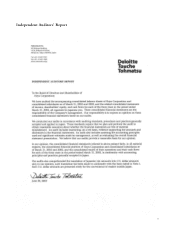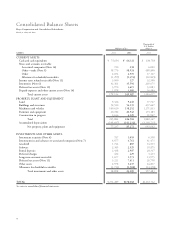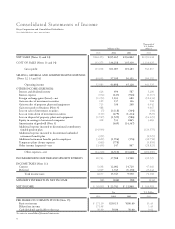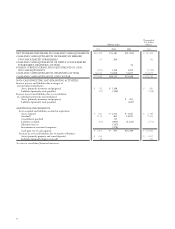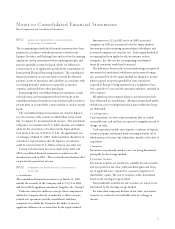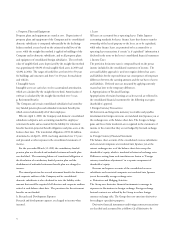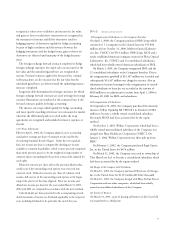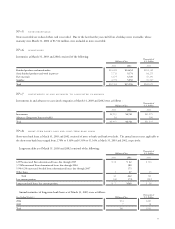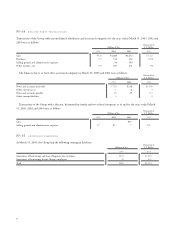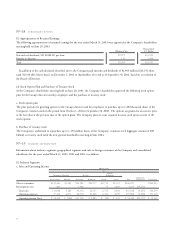Pentax 2003 Annual Report Download - page 44
Download and view the complete annual report
Please find page 44 of the 2003 Pentax annual report below. You can navigate through the pages in the report by either clicking on the pages listed below, or by using the keyword search tool below to find specific information within the annual report.42
e. Property, Plant and Equipment
Property, plant and equipment are stated at cost. Depreciation of
property, plant and equipment of the Company and its consolidated
domestic subsidiaries is computed substantially by the declining-
balance method at rates based on the estimated useful lives of the
assets, while the straight-line method is applied to buildings of the
Company and its domestic subsidiaries, and to all property, plant
and equipment of consolidated foreign subsidiaries. The net book
value of tangible fixed assets depreciated by the straight-line method
was approximately 44.6% of total tangible fixed assets in 2003 and
42.8% in 2002. The ranges of useful lives are from 10 to 50 years
for buildings and structures and from 5 to 10 years for machinery
and vehicles.
f. Intangible Assets
Intangible assets are carried at cost less accumulated amortization,
which are calculated by the straight-line method. Amortization of
software is calculated by the straight-line method over 5 years.
g. Retirement Benefits
The Company and certain consolidated subsidiaries had contribu-
tory funded pension plan and unfunded retirement benefit plan
which covered substantially all of their employees.
Effective April 1, 2000, the Company and domestic consolidated
subsidiaries adopted a new accounting standard for employees'
retirement benefits and accounted for the liability for retirement
benefits based on projected benefit obligations and plan assets at the
balance sheet date. The transitional obligation of ¥3,166 million,
determined as of April 1, 2000, was being amortized over 15 years
and presented as other expense in the consolidated statements of
income.
For the year ended March 31, 2003 the contributory funded
pension plan was dissolved and unfunded retirement benefit plan
was abolished. The remaining balance of transitional obligation at
the dissolution of contributory funded pension plan and the
abolishment of unfunded retirement benefit plan was charged to
income.
The annual provision for accrued retirement benefits for directors
and corporate auditors of the Company and its consolidated
domestic subsidiaries is also calculated to state the liability at the
amount that would be required if all directors and corporate auditors
retired at each balance sheet date. The provisions for the retirement
benefits are not funded.
h. Research and Development Expenses
Research and development expenses are charged to income when
incurred.
i. Leases
All leases are accounted for as operating leases. Under Japanese
accounting standards for leases, finance leases that deem to transfer
ownership of the leased property to the lessee are to be capitalized,
while other finance leases are permitted to be accounted for as
operating lease transactions if certain “as if capitalized” information is
disclosed in the notes to the lessee’s consolidated financial statements.
j. Income Taxes
The provision for income taxes is computed based on the pretax
income included in the consolidated statements of income. The
asset and liability approach is used to recognize deferred tax assets
and liabilities for the expected future tax consequences of temporary
differences between the carrying amounts and the tax bases of assets
and liabilities. Deferred taxes are measured by applying currently
enacted tax laws to the temporary differences.
k. Appropriations of Retained Earnings
Appropriations of retained earnings at each year end are reflected in
the consolidated financial statements for the following year upon
shareholders’ approval.
l. Foreign Currency Transactions
All short-term and long-term monetary receivables and payables
denominated in foreign currencies are translated into Japanese yen at
the exchange rates at the balance sheet date. The foreign exchange
gains and losses from translation are recognized in the statements of
income to the extent that they are not hedged by forward exchange
contracts.
m. Foreign Currency Financial Statements
The balance sheet accounts of the consolidated overseas subsidiaries
and associated companies are translated into Japanese yen at the
current exchange rates as of the balance sheet dates except for
shareholders’ equity, which is translated at historical exchange rates.
Differences arising from such translation are shown as “Foreign
currency translation adjustments” in a separate component of
shareholders’ equity.
Revenue and expense accounts of the consolidated overseas
subsidiaries and associated companies are translated into Japanese
yen at the monthly average exchange rates.
n. Derivatives and Hedging Activities
The Group uses derivative financial instruments to manage its
exposures to fluctuations in foreign exchange. Foreign exchange
forward contracts are utilized by the Group to reduce foreign
currency exchange risks. The Group does not enter into derivatives
for trading or speculative purposes.
Derivative financial instruments and foreign currency transactions
are classified and accounted for as follows: (a) all derivatives be



